Usk
| Usk | |
| Welsh: Brynbuga | |
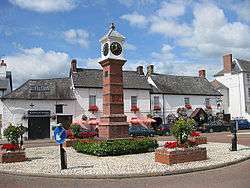 Twyn Square and clock tower |
|
 Usk |
|
| Population | 2,834 |
|---|---|
| OS grid reference | SO375005 |
| Principal area | Monmouthshire |
| Ceremonial county | Gwent |
| Country | Wales |
| Sovereign state | United Kingdom |
| Post town | USK |
| Postcode district | NP15 |
| Dialling code | 01291 |
| Police | Gwent |
| Fire | South Wales |
| Ambulance | Welsh |
| EU Parliament | Wales |
| UK Parliament | Monmouth |
| Welsh Assembly | Monmouth |
|
|
Coordinates: 51°42′13″N 2°54′07″W / 51.7035°N 2.9019°W
Usk (Welsh: Brynbuga) is a small town in Monmouthshire, south-east Wales, situated 10 miles (16 km) northeast of Newport.
.jpg)
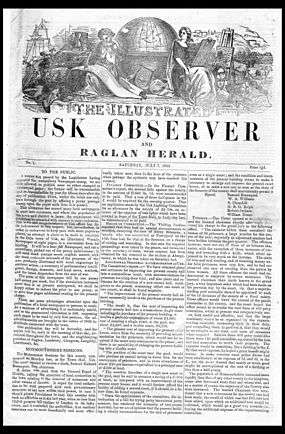
It is located on the River Usk, which is spanned by an arched stone bridge at the western entrance to the town. A castle above the town overlooks the ancient crossing point. It developed as a small market town, with some industry including the making of Japanware, and a notable prison. In recent years Usk has become known for its history of success in Britain in Bloom competitions, winning the Large Village award in 2005. The resident population of the town in 2001 was 2,318,[1] increasing to 2,834 at the 2011 census.[2]
English and Welsh names
The town takes its English name from the River Usk - a name derived from an ancient Brythonic word for river which may also mean "abounding in fish". The name resembles that of many other rivers in Britain (e.g. Exe, Esk), and is related to Scottish Gaelic uisge or uisce in Irish Gaelic ("water"), and therefore to "whisky". The Welsh name Brynbuga, (English: Buga's Hill), was first recorded in the 15th century.[3]
History
Roman times
The Roman legionary fortress of Burrium was founded on the site of Usk by the military commander Aulus Didius Gallus, around AD 55. He moved his XX Valeria Victrix legion into the area from its earlier base at Glevum (Gloucester).[4] It was the earliest legionary fortress in Wales. Although the site was constricted by hills, subject to flooding, and not on a navigable river, it offered good communications inland up the River Usk. However, by around AD 75 its disadvantages had become apparent and the Romans relocated their permanent military base south to Caerleon, leaving only a small auxiliary fort and civilian settlement at Usk.[4]
The fortress at Usk was surrounded by ramparts and covered a large area. The Roman remains are buried on the southern side of the town,[5] but the extent of the Roman forts at Usk may be traced on the ground by means of plaques set into the pavement.[6] Many of the Roman finds from Usk are now housed in the National Roman Legion Museum in Caerleon.[4]
Norman times
After the fortress was abandoned, it continued to be occupied as a civilian settlement, with evidence of iron working. The Normans also realised Usk's geographical and military importance within the region, and the powerful de Clare family built Usk Castle as part of their plans for controlling the area's resources and people. The castle, now hidden from view by surrounding trees planted in the early 20th century, is one of the few castles still privately owned and occupied.[7]
Between 1154 and 1170, Richard de Clare, 2nd Earl of Pembroke established a planned town, surrounded by an earthen rampart.[6] The town was laid out in rectangular building plots, centred on the market square. Markets were originally held in Twyn Square, twyn being a Welsh word for "hillock".[4]
The de Clare lords and their successors established a hospital for lepers on the north side of the town bridge. Its charitable function probably died out in the 14th century, along with the disease. A plaque marks the site.[6] The bridge itself was originally a wooden structure, first recorded in 1383, when it was reported to be in need of repair.[4]
Charters
A Benedictine priory was founded around 1170, and part of the building is retained in the church of St. Mary. It was reduced in size after Dissolution of the Monasteries in 1536. The tomb of the last Prioress may be seen beside the path through the churchyard.[6] The town was incorporated by charters granted by Edmund Mortimer, Edward II, Edward IV, and succeeding monarchs.[8] Its location meant that it was inevitably frequently caught up in the border disputes between the English and the Welsh in this section of the Welsh Marches.
The Welsh Revolt
Usk was the birthplace of Adam of Usk. His chronicle records the 'Welsh Revolt' in 1403, when Owain Glyndŵr burned Usk to the ground while gaining control of much of South Wales from the English under King Henry IV and his son, later to become King Henry V. The important Battle of Pwll Melyn in 1405 occurred immediately north of Usk Castle, when English forces routed their Welsh opponents, causing much loss of life, including that of Owain's brother Tudur. After their defeat, three hundred Welsh prisoners were executed in front of the castle.[9] In 2005 the 600th anniversary of the battle of Pwll Melyn was commemorated by a son-et-lumiere show at the castle.
The town appears as "Uck" and "Branbuga" on the Cambriae Typus map of 1573.[10]
The 16th and 17th centuries
The Great House of the town, later subdivided into smaller units, was built on Old Market Street in the mid-16th century for the Williams family. Its original entrance was at the rear of the present building, and faced onto gardens and meadows. Though much altered, the building retains many original features including chimney stacks and decorative plaster ceilings.[4][5]
The town market was moved from Twyn Square in 1598 to a location closer to the river, at New Market Street. A new Town Hall was built on the street at the same time; this was later partially rebuilt at several times during the 19th century, and is now used by the Royal British Legion.[4][5]
In 1621 the wealthy Midlands wool merchant Roger Edwards, the owner of Allt-y-Bela in Llangwm, founded Usk Grammar School.[11]
The 18th and 19th centuries
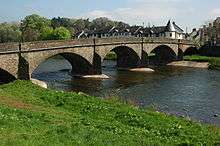
The first stone bridge at Usk, replacing one of wood, was built around 1750 to the designs of Welsh architect William Edwards. Unlike the bridge downstream at Caerleon, it withstood the great floods of 1795. The bridge was strengthened and widened in 1836, but two of its arches were destroyed by floods in 1877 and later replaced.[4]
From the late 18th century, Usk became well known for the high quality of its japanware,[4] a process of decorating metals by applying a lacquer to tinplate. The process, known as Pontypool japan, was first developed in the west by Thomas Allgood of nearby Pontypool and was taken on in Usk in 1763 by his grandsons Thomas and Edward Allgood. Products from Usk included tin trays, jardinières, and coal boxes. However output declined with changing fashions in the 19th century, and the last Usk japanware was produced in 1860 on the site of what is now Bunning's builders' merchants.[4][12]
Usk was a thriving market town in the first part of the 19th century, when many of its existing buildings were constructed, and into the Victorian era, although its population fell in the second half of the century as a result of agricultural depression.[5]
Amenities
The town is known for its pubs, restaurants and antique shops. The narrow main street, Bridge Street (the A472), has a collection of old houses, restaurants, pubs, shops and businesses, with some premises dating back to the 15th century.
The road passes Twyn Square, a large town square. The clock tower in the square was erected to commemorate the Golden Jubilee of Queen Victoria in 1887.[4] Opposite is an art gallery, Gallery in the Square. The twice-monthly Usk Farmers' Market is held in the town's Memorial Hall.
"Usk Island" is a park at the edge of the river ('island' is a literal translation of the Welsh 'ynys' meaning a river meadow). The park is mostly laid to grass, with surrounding woodland. It also has a substantial adventure playground. Usk Tennis Club was Tennis Wales "Club of the Year" for 2006.[13]
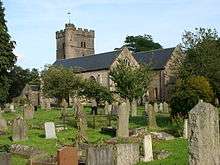
The BBC reported in May 2014 that Wales' rarest tree, Ley's Whitebeam (Sorbus leyana), will be planted in Usk to honour the man who rediscovered them, Peter Charlesworth.[14]
Priory Church of St Mary, Usk and the Priory Gatehouse
The parish church of St Mary originated as part of the Benedictine priory founded by Richard de Clare in the 12th century. The northern aisle of the convent church was added in the 13th century for the use of the town's residents, and after the Dissolution of the nunnery in 1536 the nave was also incorporated as part of the parish church. The original 12th-century crossing remains, as does an original font. Most of the structure derives from the 14th century, although the two porches and the notably fine rood screen date from the 15th century and were probably built for William Herbert, Earl of Pembroke, who was Constable of the castle. The church was partly rebuilt and extended around 1844 by the architect T. H. Wyatt, and further restored and extended in 1899-1900.[4][15]
The priory's poor finances were improved in 1404 by a Papal indulgence obtained by Adam of Usk, who was buried beside the priory altar; there is a brass monument to him in the church. Usk later became a centre for pilgrims. The gatehouse of the original convent survives beside the main entrance to the churchyard. However, most of the priory buildings, such as the cloister and chapter house, were destroyed and their stones later used in town buildings.[4][16]
Sessions House
In April 2011, following a 12-year restoration costing £200,000, the court room at the Sessions House was re-opened with Usk Town Council now using it as its base. As well as the court room, the council has also reopened the library, which contains thousands of books, some dating back to the 1600s.
The building containing two separate courts, was designed by T. H. Wyatt and built in 1877. High-profile cases heard there included the prosecution of Viscountess Rhondda, a prominent suffragette who subsequently was released after a hunger strike.[17] Another notable trial was that of the Spanish sailor Josef Garcia, convicted of murdering William and Elizabeth Watkins and their three youngest children (Charlotte, 8 years, Alice, 5 years and Frederick, 4 years) in 1878 at Llangibby.[18]
Court one was gutted by fire in 1944 and was never rebuilt. But the remaining court two has been described as ".. unique, the only truly authentic Victorian court room left in Britain." When court one burnt down the remaining court was not large enough to act as a Crown Court. Newport Crown Court took over as Gwent's Crown Court when it opened in 1974.
The restoration fund included over £100,000 raised by local people, with a £90,000 National Lottery grant and £5,000 from Monmouthshire County Council which paid for repairs to the roof and stone walls. The dock, the Judge's chair and the benches for witnesses, jury, clerks and reporters have also been restored, varnished and re-upholstered with horsehair. Paintings of session judges on the walls have also been restored and framed, while the walls have been repainted in their original red colour.
The docks of both court rooms were originally linked by a tunnel to Usk Prison next door. After the opening of Newport Crown Court the Sessions House was a Magistrates' Court until 1995. In 1998 Usk Town Council bought it from Monmouthshire council for £90,000 and restoration began. The Sessions House is now also licensed for weddings.[19]
Prison
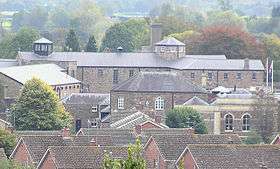
HM Prison Usk is situated close to the centre of the town. It was built in 1842-44 of Victorian 'rotunda' design, similar to that of Pentonville in London. The architect was T. H. Wyatt. It became the County Gaol for Monmouthshire in 1870, and operated until 1922. After being closed for more than a decade, it was reopened in 1939, adapted for use as a borstal to hold youth. In 1990 it adapted for use as a Category C establishment for Vulnerable Prisoners, including sex offenders.[20]
The sister establishment of HM Prison Usk is HM Prison Prescoed, which is located three miles to the south-west of the town towards Pontypool.
Usk Rural Life Museum
The Rural Life Museum is housed in a former malt barn, possibly of mediaeval origin, on New Market Street. Run by volunteers, it focuses on life in the area as it was between the mid-19th and mid-20th centuries. It is open to visitors between April and October.[21]
Usk Natural Burial Meadow
Usk Natural Burial Meadow is a 14-acre (5.7 ha) site in Usk Castle Chase that offers full interments, and the burial or scattering of cremation ashes.[22] The site is located 1 mile (1.6 km) from the town centre along Monmouth Road and was established in 2005.[23] It was awarded Cemetery of the Year in 2008 by the Institute of Cemetery and Crematorium Management (ICCM).[24]
Usk in Bloom
Local residents formed the Usk in Bloom committee in 1980. The voluntary committee aims to improve the local environment by the imaginative planting of trees, shrubs, bulbs and floral displays; and to foster partnerships with other organisations and residents for work on environmental issues in the town. The town won the "Wales in Bloom" competition for 27 times in a row between 1982 and 2010;[25] won the "large village" category of "Britain in Bloom" four times; and twice represented the United Kingdom in European competitions.[26]
Administration
The town is administered by Monmouthshire County Council and a town council. The mayor elected to serve in 2016-17 is Tim Keenan.
Twin town
Usk was twinned with the German town Graben-Neudorf in Baden-Württemberg in 1980. Over the past few years there have been numerous visits between the two towns, with the Usk Youth Brass Band making its most recent visit in autumn 2006. In 2006 the colour scheme of Usk in Bloom was based on those within the crests of both Usk and Graben-Neudorf.
Notable people
The town was the birthplace of the priest and chronicler Adam of Usk, around 1352. In 1679 Usk was the site of the martyrdom of Jesuit father David Lewis, who was hanged for his alleged part in the fictitious Popish Plot conspiracy of Titus Oates.[27] In 1823 Llanbadoc, just across the river from Usk, was the birthplace of Alfred Russel Wallace, notable proponent of the theory of evolution.
Neighbouring areas
The South Wales Gliding Club is located near Gwernesney, about three miles east of the town. About three miles (5 km) west of Usk is the 1,000-acre (4.0 km2) site of the munitions production facility of BAE Systems at Glascoed.
Gallery
 General view of the town
General view of the town Tower of Usk Castle
Tower of Usk Castle Twyn Square during the Britain In Bloom competition, 2007
Twyn Square during the Britain In Bloom competition, 2007 Former Congregational chapel, now used as a commercial art gallery
Former Congregational chapel, now used as a commercial art gallery View westwards along Bridge Street
View westwards along Bridge Street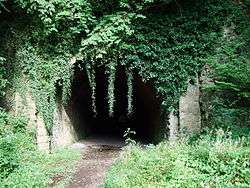 Usk railway tunnel
Usk railway tunnel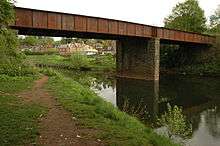 Disused railway bridge at Usk
Disused railway bridge at Usk
See also
- Usk (hundred)
- Usk (GWR) railway station, including a description of Usk Tunnel
References
- Newman, John (2000). Gwent/Monmouthshire. The Buildings of Wales. Penguin. ISBN 0140710531.
- ↑ ONS, 2001 Census, Usual Resident Population
- ↑ "Town and ward populations 2011.Retrieved 4 April 2015".
- ↑ Hywel Wyn Owen, The Place-names of Wales, 1998, ISBN 0-7083-1458-9
- 1 2 3 4 5 6 7 8 9 10 11 12 13 Usk Civic Society, Usk Town Trail, 2010
- 1 2 3 4 John Newman, The Buildings of Wales: Gwent/Monmouthshire, 2000, ISBN 0-14-071053-1
- 1 2 3 4 Usk Town Visitor's Guide, published by the Usk Town Visitors Guide Committee, July 2010
- ↑ "Official Website". Usk Castle. Retrieved 2011-01-14.
- ↑ "Usk, Monmouthshire - Extract from National Gazetteer, 1868". GENUKI. 2009-02-17. Retrieved 2011-01-14.
- ↑ Battles and Campaigns from The Chronicle of Adam of Usk
- ↑ A reproduction of the map is at File:Atlas_Ortelius_KB_PPN369376781-011av-011br.jpg
- ↑ Newman, 2000, p.595
- ↑ Japanware.org - Pontypool and Usk rivalry
- ↑ Usk Tennis Club. Retrieved 6 April 2011.
- ↑ BBC News, "Rare trees planted to honour man who discovered them", 15 May 2014
- ↑ John Newman, The Buildings of Wales: Gwent/Monmouthshire, 2000, ISBN 0-14-071053-1, pp.584-596
- ↑ Monastic Wales: Remnants of Usk Priory
- ↑ "2nd Viscountess Rhondda, Politician and businesswoman" at bbc.co.uk
- ↑ Roger Williams (2004), Their Deadly Trade: Murders in Monmouthshire, Gomer Press. ISBN 1-84323-389-4
- ↑ "Historic Usk courthouse opens doors again" by Chris Wood at southwalesargus.co.uk
- ↑ HMP USK Prison Regime Information
- ↑ Usk Rural Life Museum
- ↑ Usk Natural Burial Meadow
- ↑ "Net cemetery", South Wales Argus, 31 May 2007. Retrieved 2 July 2016
- ↑ ICCM
- ↑ Usk Town Council, Usk wins Wales in Bloom for the 27th time in a row
- ↑ Usk in Bloom
- ↑ Roberts, Alun (2002). Welsh National Heroes. Y Lolfa. p. 40. ISBN 9780862436100. Retrieved 2014-07-12.
External links
| Wikimedia Commons has media related to Usk. |
| Wikivoyage has a travel guide for Usk. |